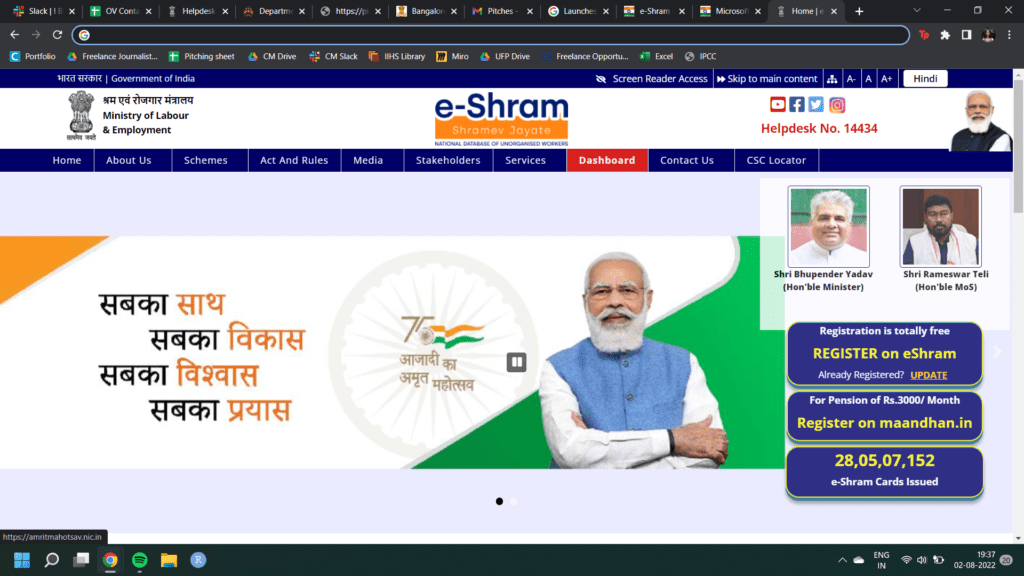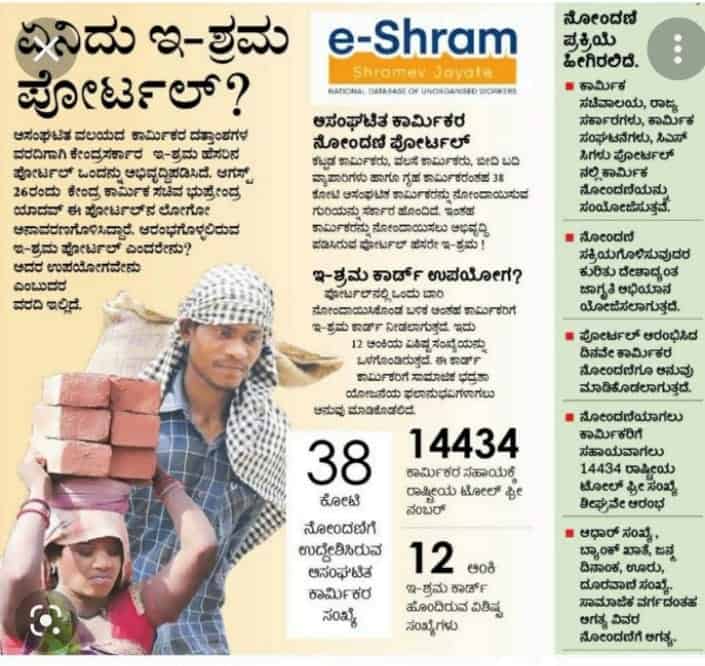The objective of the digital initiative was laudable. A national portal that would enable the 411 million workers in the informal sector (as per the estimates by the Periodic Labour Force Survey 2017-18) to access national and state schemes, offering such workers health, employment and social security benefits.
The country had been a mute witness to the devastating impact of the pandemic and unprecedented lockdown on these workers, especially migrant workers, as they faced sweeping job losses, loss in income and hunger.
With the objective of preventing a repeat of this human tragedy, the Union Ministry of Labour and Employment in August 2021 launched the E-shram portal aimed at creating a national database for the unorganised sector workers. The portal was launched to provide centralised social security benefits to the beneficiaries via Direct Benefit Transfers (DBTs) for the registered home-based, self-employed, and daily wage workers in the eventuality of another national emergency like COVID-19. It also provides accident benefits to the registered.
It was meant to streamline social security and other schemes announced by the Union and state governments and enable informal workers, who are not beneficiaries of either the provident fund scheme or the employees’ state insurance scheme, wherever they are based, to access these schemes.
What is e-shram?

Anyone aged between 16-59 years, who doesn’t pay income tax and works in the unorganised sector can register as an eligible beneficiary on the portal. Post registration, they are assigned a 12-digit Unique Account Number and an e-shram card. Bank account details and a mobile number linked to the worker’s Aadhaar card is mandatory for registration.
The listed benefits for registered workers include an accident insurance cover of Rs 2 lakh under the Pradhan Mantri Suraksha Bima Yojana. The workers are also entitled to any social security benefits the government might announce in the future when there is a nationwide emergency like the COVID-19 pandemic. (More details can be found here.)
The portal has an option where workers can register on maandhaan.in, which is a voluntary and contributory pension scheme to receive a pension amount of Rs 3,000 per month when the beneficiary attains the age of 60 years. This is available to unorganised workers between the ages of 18-40 years with a monthly income of Rs15,000 or less. This is a self-registration scheme where the beneficiary’s monthly, quarterly or half-yearly contributions get auto-debited. Like e-shram, this too requires an Aadhaar card and a functional bank account.
An official manning the e-shram helpline number told me that 28.4 crore workers across India and 69.10 lakh workers in Karnataka are currently registered on the portal.
Snags in implementation
There are several organisations that are committed to getting unorganised and informal workers registered with the portal. Like the social security initiative team at Hasiru Dala, a Bengaluru-based social impact organisation, working mainly on waste management. The organisation has identified several such workers across BBMP zones. Although the team has been going to the homes of these workers with their laptops to initiate the registration process, their efforts have hit several snags.
“Often the workers’ phone numbers aren’t seeded with their Aadhaar cards because they don’t always use a single phone number,” said Kasturi P, a community facilitator at Hasiru Dala. “They might lose their phones or if they haven’t recharged them in a while, their SIMs might be considered invalid, in which case the registration does not happen”.
Kasthuri and her colleague Shreedevi said sometimes the workers also do not have bank accounts or sufficient minimum balance, resulting in their accounts being closed.

Because they have heard of this scheme, the workers sometimes go to cyber cafes to get their registration done. “But the cafes often enter inaccurate bank account numbers causing incomplete registration but charge the workers at least Rs 200-300 for this,” said Kasthuri. Also, according to the facilitators, workers are miffed with the government modifying, replacing and even shelving schemes. “Because of the gaps in information and constant modifications, they have lost faith in the state’s social security initiatives” added another Hasiru Dala official who wished to remain anonymous.
Read More: Are informal workers in any better state this lockdown?
Dearth of information
While there are several volunteers like Kasthuri and Shreedevi who are helping workers with enrollment, they themselves are unaware of the exact benefits under the scheme. “We do not have clarity on what the scheme is, but domestic workers had heard about the benefits on TV and insisted on getting themselves enrolled,” says Radha K, an activist with Domestic Workers Rights Union, Karnataka who has helped enroll over 1,000 domestic workers in South Bengaluru. “The workers believe rumors going around about receiving Rs 3,000 or Rs 5,000 once they are enrolled, but that seldom happens,” added Radha.
Sandhya M, a domestic worker in Ragigudda, was among those whom Radha helped enrol. Sandhya and her husband, who works as a construction worker, received their e-shram cards a week after they registered. “They told me it’s some accident policy, but I don’t know a lot about the scheme” Sandhya admitted when I asked her why she registered for the portal. They had no idea that e-shram is to be used only in case of a future eventuality like COVID-19.
Radha recollects how a member of the union had mentioned NIMHANS asking them for e-shram card as valid identification proof. “But she thought that the e-shram card would lead to a reduction of medical expenses at NIMHANS, just as a Below Poverty Level (BPL) card does, but was disappointed to learn that it doesn’t,” said Radha.
There are organisations that are actively trying to bridge this misinformation gap. Muniraju T, who works with India LabourLine, refers workers to their nearest Common Service Centre (CSC) where they can get all the necessary information before registering on the portal. He and his team are also going to labour stands and distributing pamphlets, explaining the benefits of the portal and providing a national helpline run by the team that they can reach out to.

Echoing Radha’s concerns, Appanna, General Secretary of the All Indian Central Council for Trade Unions said while workers have been steadily registering themselves on the portal, they aren’t completely sold on the idea of it. “The government keeps churning out new cards like this but we rarely see tangible benefits,” said Appanna.
Lack of decentralised focus
When the labourers visit the service centre to get their voter’s ID, PAN cards, or ration cards done, staffers there do try to inform them about the portal and encourage them to register but with little success. “Even if we talk about the benefits of the portal, the workers are not ready to get enrolled,” said an official at their MS Palya centre. “Because they have no knowledge about the initiative, they claim it is of no use to them despite us explaining the benefits”.
Additionally, as this is a central scheme, there is very little effort from the BBMP or other state agencies to popularise it among workers. An official who requested anonymity said when the portal was initially rolled out, there were a lot of advertisements for the first two months and then it fizzled out.
Palani Swamy at the Koramangala CSC said they visited a settlement in Rajendra Nagar near Adugodi, and started an enrollment drive for the workers, including migrants. He is optimistic about the portal being a means to provide benefits like scholarships, bus passes and pension plans despite the registrations being slow.
None of those working to get workers registered on the portal had any data on registrations in Bengaluru and reiterated that there is no nodal agency at the city level to oversee implementation. This disconnect at the last mile is the main reason why workers are largely not registering on it.
What the portal got right
Radha says the portal is fairly easy to operate and that anyone with minimum basic technical knowledge can successfully register. “It is also much better than the smart card portal for domestic workers, which is riddled with glitches,” said Radha.
The e-shram portal is also among the first to allow self-registration of workers, choose the sector they are employed in and in what capacity. It is location-agnostic as it can deliver social security benefits to labourers who are shifting places, like migrant or construction workers.
E-shram Helpline- 14434
LabourLine Helpline- 18001374150
In case of grievances like wage disputes or problems with Provident Fund, workers can call this national helpline and officials will mediate between them and their employer/contractor to resolve it.
Through the Find my CSC section of the portal, workers can get a list of help centres in their vicinity, who can assist in registration and provide the necessary information. While the portal’s objectives look good on paper, the many gaps in implementation mentioned above is what the state should pay heed to at this point.